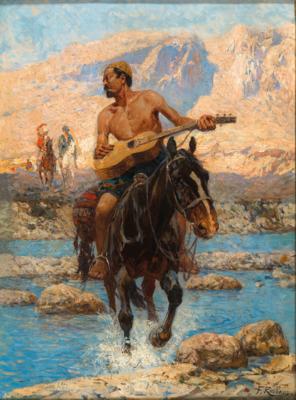Franz Roubaud

(Odessa 1856–1928 Munich)
A Rider with Guitar Crossing a Ford, signed F. Roubaud, oil on panel, 43 x 32 cm, framed
Provenance:
Private Collection, Germany.
We are grateful to Dr. Olga Sugrobova-Roth for her scholarly advice and for kindly confirming the authenticity on the basis of the original.
Franz Roubaud was born into a French family in Odessa, was a native French speaker and retained French citizenship until 1914. His parents sent him to the Odessa drawing school in the year it opened (1865). It is possible that Roubaud first heard of the Bavarian Academy at the Odessa drawing school: one of the teachers there was a Munich graduate, Anton Bauer. In Munich he entered the private school of Józef von Brandt and joined the circle of Polish artists.
Roubaud’s work is mainly associated with the Caucasus. A trip to Tbilisi with his parents in the 1870s had a decisive influence on him. Roubaud was by no means the first to depict the world of the steppes and southern mountains at the exhibitions in St. Petersburg and Munich, but he was undoubtedly the first to convey the heat so convincingly to the viewer. He was able to impressively reproduce the sun, the dusty road trodden by horses, the hot stones and the sand in his paintings. The artist remained true to his preferred grey-yellow “steppe” colour palette throughout his career. It became more complex and expressive in the 1890s when the artist moved to coloured backgrounds, and gained a certain intensity in his later years. He was not seduced by exoticism and eschewed the “intoxicatingly fragrant Orient”, instead depicting the harsh and dangerous environment that shaped the character of his taciturn figures. Occasionally, the loneliness and extremes of their surroundings drive Roubaud’s riders to play a musical instrument or sing. Roubaud also painted pictures that give us a glimpse of real life in Central Asia and the Caucasus: the bazaars, the resting caravans, the loaded wagons. Some of Roubaud’s motifs were extremely popular for decades, and at first glance the artist always seems to paint the same thing. However, comparison reveals he never completely repeats himself, but paints a Circassian horseman or a river crossing anew each time.
Roubaud’s art is an organic part of the orientalist and battle painting genres of the late 19th and early 20th centuries. Once he found his individual signature, however, the immediacy of his work set him apart from this general context. Nevertheless, Roubaud’s potential is evident not just in his large compositions, but also in his smaller works, studies and sketches, in which he reveals his ability to work with different techniques. He did not cleave to a single technique in his oeuvre, but painted with oil on canvas, wood, and cardboard and worked with tempera and pastels. Great interest in Roubaud was rekindled in the 1970s and his catalogue raisonné was published in 2012.
Expert: Mag. Dimitra Reimüller
 Mag. Dimitra Reimüller
Mag. Dimitra Reimüller
+43-1-515 60-355
19c.paintings@dorotheum.at
08.11.2022 - 17:00
- Dosažená cena: **
-
EUR 19.200,-
- Odhadní cena:
-
EUR 8.000,- do EUR 14.000,-
Franz Roubaud
(Odessa 1856–1928 Munich)
A Rider with Guitar Crossing a Ford, signed F. Roubaud, oil on panel, 43 x 32 cm, framed
Provenance:
Private Collection, Germany.
We are grateful to Dr. Olga Sugrobova-Roth for her scholarly advice and for kindly confirming the authenticity on the basis of the original.
Franz Roubaud was born into a French family in Odessa, was a native French speaker and retained French citizenship until 1914. His parents sent him to the Odessa drawing school in the year it opened (1865). It is possible that Roubaud first heard of the Bavarian Academy at the Odessa drawing school: one of the teachers there was a Munich graduate, Anton Bauer. In Munich he entered the private school of Józef von Brandt and joined the circle of Polish artists.
Roubaud’s work is mainly associated with the Caucasus. A trip to Tbilisi with his parents in the 1870s had a decisive influence on him. Roubaud was by no means the first to depict the world of the steppes and southern mountains at the exhibitions in St. Petersburg and Munich, but he was undoubtedly the first to convey the heat so convincingly to the viewer. He was able to impressively reproduce the sun, the dusty road trodden by horses, the hot stones and the sand in his paintings. The artist remained true to his preferred grey-yellow “steppe” colour palette throughout his career. It became more complex and expressive in the 1890s when the artist moved to coloured backgrounds, and gained a certain intensity in his later years. He was not seduced by exoticism and eschewed the “intoxicatingly fragrant Orient”, instead depicting the harsh and dangerous environment that shaped the character of his taciturn figures. Occasionally, the loneliness and extremes of their surroundings drive Roubaud’s riders to play a musical instrument or sing. Roubaud also painted pictures that give us a glimpse of real life in Central Asia and the Caucasus: the bazaars, the resting caravans, the loaded wagons. Some of Roubaud’s motifs were extremely popular for decades, and at first glance the artist always seems to paint the same thing. However, comparison reveals he never completely repeats himself, but paints a Circassian horseman or a river crossing anew each time.
Roubaud’s art is an organic part of the orientalist and battle painting genres of the late 19th and early 20th centuries. Once he found his individual signature, however, the immediacy of his work set him apart from this general context. Nevertheless, Roubaud’s potential is evident not just in his large compositions, but also in his smaller works, studies and sketches, in which he reveals his ability to work with different techniques. He did not cleave to a single technique in his oeuvre, but painted with oil on canvas, wood, and cardboard and worked with tempera and pastels. Great interest in Roubaud was rekindled in the 1970s and his catalogue raisonné was published in 2012.
Expert: Mag. Dimitra Reimüller
 Mag. Dimitra Reimüller
Mag. Dimitra Reimüller
+43-1-515 60-355
19c.paintings@dorotheum.at
|
Horká linka kupujících
Po-Pá: 10.00 - 17.00
kundendienst@dorotheum.at +43 1 515 60 200 |
| Aukce: | Obrazy 19. století |
| Typ aukce: | Sálová aukce s Live bidding |
| Datum: | 08.11.2022 - 17:00 |
| Místo konání aukce: | Wien | Palais Dorotheum |
| Prohlídka: | 22.10. - 08.11.2022 |
** Kupní cena vč. poplatku kupujícího a DPH
Není již možné podávat příkazy ke koupi přes internet. Aukce se právě připravuje resp. byla již uskutečněna.
